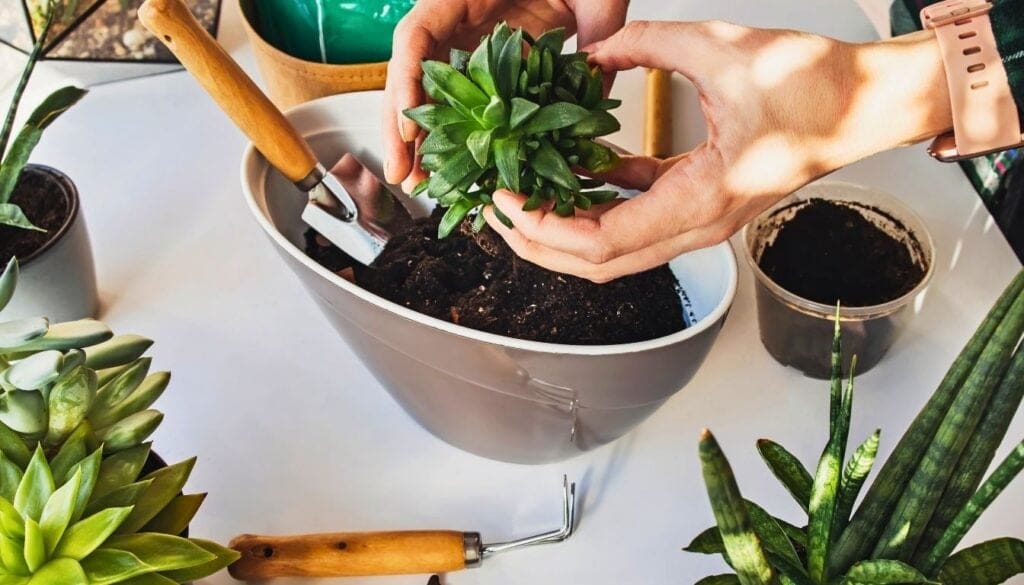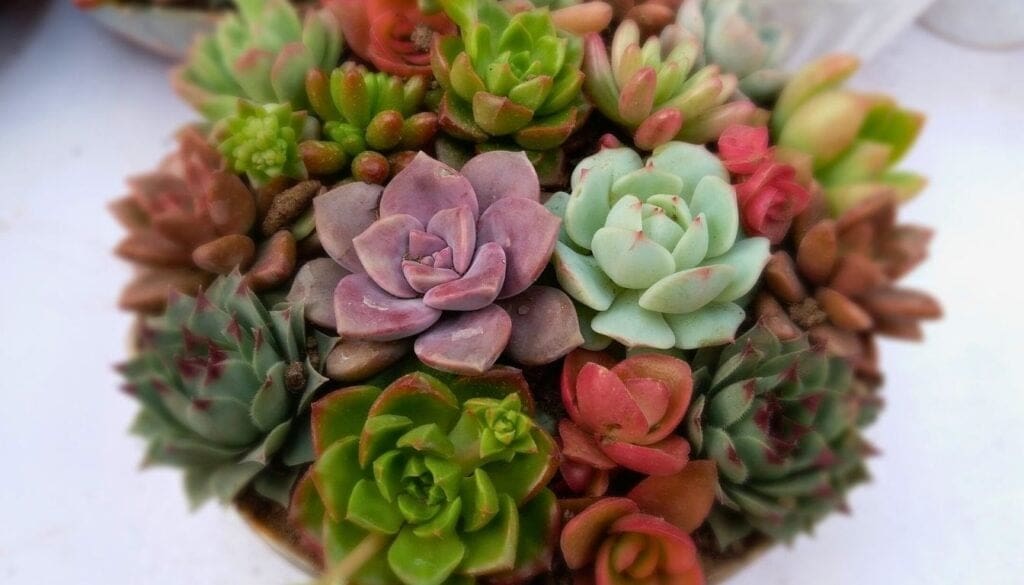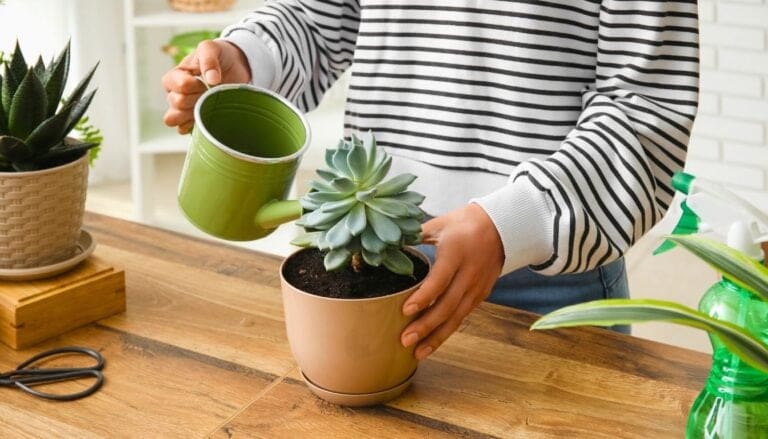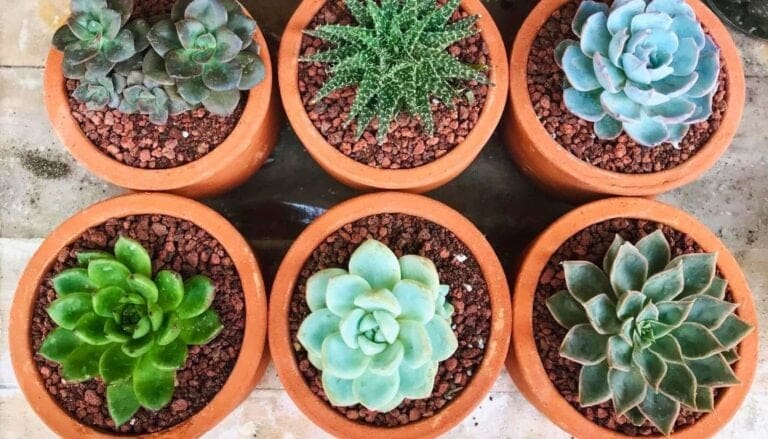9 Tips for Potting Succulents Indoors!
I’ve found that potting succulents indoors can be a fantastic way to bring some greenery into my home. They’re not only stylish but also easy to care for.
What’s the best way to start potting succulents indoors? It’s a common question that many plant enthusiasts have, and I’ve got some great tips to share.
Succulents can brighten up any room and lift the overall mood of the house. Plus, they come in so many varieties, which makes them super fun to collect. 🌵
Have you ever tried growing succulents? It’s like a cool little indoor adventure! 😊

Please note: Simplify Plants is reader-supported. As an Amazon Associate, I earn from qualifying purchases made by our readers with no extra cost added to you all! Some links in the post are affiliate links and I get a commission from purchases made through links in the post.
1) Choose the Right Pot
Picking the right pot for your succulents is like picking the right outfit for a party. You want it to look good, but it has to be practical too! 😄
First, consider drainage. Succulents don’t like sitting in water, so a pot with a hole is a must.
Trust me, I made that mistake once, and my poor plant didn’t make it.
Speaking of size, don’t go too big. A large pot holds more soil, which can lead to too much moisture.
A snug fit keeps the balance just right.
Material matters too. Clay pots are great because they breathe, letting the soil dry out between waterings. Plastic ones can work, but you might need to water less often.
And hey, have some fun with it! There are so many colors and styles to choose from. Why not pick something that makes you smile every time you see it? 🌟
Have you picked out the perfect pot yet? Let me know what you chose in the comments! 🪴
2) Use Well-Draining Soil

When it comes to potting succulents, well-draining soil is a must! 🌵
Trust me, I’ve tried using regular potting soil, and let’s just say my succulents weren’t exactly happy campers.
Why does this matter? Succulents don’t like wet feet. They need soil that lets excess water escape quickly.
I remember the first time I repotted my aloe plant. At that time, I wasn’t paying attention to the soil. It stayed drenched for days! My aloe wasn’t thrilled.
That’s when I realized the magic of soil made especially for succulents.
You can find specially-made succulent soil mixes at most garden stores. These mixes often contain materials like sand, pumice, or perlite. These help water drain better.
It’s like giving your succulents their favorite cozy pair of shoes. 😊
If you’re a DIY enthusiast, you can mix your own, too! Use a mix of potting soil, coarse sand, and perlite. It’s simple and fun to make your plants feel right at home.
Do you use regular potting soil or special succulent mix for your little green buddies? Let me know! I’d love to hear how it’s going with your plants. Just remember, happy soil means happy succulents! 🌿
3) Find the Perfect Spot
Finding the right spot for your succulents is like finding their sweet home. 🌿
They love bright light but not too much direct sun. A window sill that gets filtered sunlight can be perfect. Do you have such a spot in your place?
I once made the mistake of putting mine near a heat vent. Oops! They didn’t like that at all. 🚫
Succulents prefer warmth, but they hate being too hot and dry.
Think about trying a north or east-facing window. It gives enough light without scorching them.
Sometimes, I rotate my plants so each gets a fair share of light. It’s like turning them around at a photoshoot! 📸
If you notice leaves stretching toward the light, they might not be getting enough. Just moving them a little could make a big difference.
Remember, your goal is to create a cozy, sunny spot that mimics their natural desert setting. 🌞
But don’t worry if you don’t get it perfect right away. I’m still experimenting with new spots in my home too. How about you? Any favorite places for your plants?
Picking the right place is like a fun puzzle. Once you solve it, your succulents will look happy and thriving. Thrilled to have found mine, I’m always on the lookout for new spots to try!
4) Water Sparingly

When it comes to succulents, less is more. I learned this the hard way after overwatering a few of my plant friends. 😅
Too much water can lead to droopy leaves and even rot.
I water my succulents like a dry desert is their home. I wait until the soil is completely dry before reaching for the watering can.
This might mean giving them a drink every couple of weeks, especially in winter.
Ever notice those thick, juicy leaves? They store extra water! That’s their superpower.
So, when you water, it’s like giving them a bonus hydration—they love it but don’t need it all the time.
I use pots with drainage holes because drainage is key. No drainage means water sits like an unwanted guest, causing problems.
Pots that drain well keep my succulents happy and healthy.
Have trouble deciding when to water? I do a simple check.
I stick my finger about an inch deep into the soil. If it’s dry, it’s time for a splash. If not, I leave them be.
Remember, succulents come from deserts. They’re used to dry spells. Whenever you’re unsure, just think like a cactus might think. 🌵
5) Rotate Regularly

I often notice that my succulents start leaning toward the light. Do yours do that too? It’s like they’re stretching to say, “Hey, look at me!” 😄
To keep them looking their best, I rotate my succulents regularly. This simple trick helps them grow evenly on all sides.
If I only water and forget to rotate, they lean, making one side plumper than the other.
Rotating them also stops those funny-looking shapes they sometimes get. Ever had a wonky succulent? It can be quite a sight!
I usually give them a spin every couple of weeks. I set a reminder on my phone so I don’t forget. How about you? Do you have a system to remember? 📅
By rotating, I also get to admire my plants from every angle. It’s like seeing them for the first time again and again.
Do you find your succulents asking for a spin? Give it a go and share your experiences. Have you ever turned yours and discovered something unexpected or cool? 🤔
6) Watch for Pests
Keeping an eye on pests is crucial when caring for succulents indoors. Just because they’re inside doesn’t mean they’re safe from tiny invaders!
Pests like mealybugs, aphids, and spider mites are sneaky, but don’t worry—I’ve got your back. 🛡️
So, how do you spot these little troublemakers? Look for white cottony spots (mealybugs), tiny green or black bugs (aphids), or fine webbing (spider mites).
Notice yellowing leaves, stunted growth, or sticky residue? These could be signs of a pest problem.
I often use a magnifying glass to double-check, and it’s kinda fun! 🔍
Worried about what to do if you find pests?
I like to gently wash my plants with soapy water or spray them with a mix of water and a tiny bit of dish soap. It’s an easy way to tackle those unwelcome guests.
If things are a bit serious, I might turn to neem oil or insecticidal soap. These are safer for the plants and me.
After all, we want our little green pals healthy and happy. 🌿
Ever had a battle with pesky bugs on your succulents? What’s your go-to trick? Share with me—I’d love to hear! 😊
7) Fertilize Occasionally

I love how low-maintenance succulents are. 🌵 They don’t need much, but a little fertilizer every now and then keeps them happy.
A light feeding once a month during the growing season can do wonders.
When I’m choosing a fertilizer, I pick a balanced one or something made just for cacti. A liquid fertilizer works best as it’s easy to mix with water.
Check the label, and make sure to use a half-strength solution.
Timing is key! I avoid fertilizing in winter because succulents are resting and don’t need extra nutrition.
Spring and summer are the best times to give them a boost.
Ever notice your succulents looking a bit pale or sluggish? It might be time to feed them.
It’s like giving them a little energy drink. 😉 Not too much, though. Over-fertilizing can harm these little plants.
After feeding, I always watch for any changes. If the leaves start looking brown or shriveled, I ease up on the fertilizer.
Every plant is different, so it’s all about finding the right balance.
Do you have a favorite fertilizer? What’s your go-to trick for helping your succulents thrive? Share your tips! ✨
8) Get Creative with Arrangements

I love mixing and matching different succulents to create a mini garden that feels unique! 🌵
It’s like putting together a puzzle with plants. Have you tried using colorful pots or even jars for your succulents?
Grouping succulents with different shapes and sizes can make a big impact. Try placing tall ones in the back and shorter ones up front. It’s fun to experiment, and there’s no wrong way to do it!
Try using unexpected items like old teacups or wooden boxes for planting. Not only are they cute, but they also add a bit of personality to your space. Do you have any fun containers lying around?
If you have space, try hanging some succulents. They look amazing in hanging baskets, and this way, they drape beautifully. Plus, hanging plants can help save room on shelves and tables.
When organizing, think about color too. Succulents come in various shades, from green to pink and even purple. Mixing these colors can make your arrangement pop! 🌈
Adding a few small stones or decorative items can really make your arrangement stand out. Just make sure your plants have enough room to breathe!
If you love crafts, try making a table centerpiece with succulents. It’s a fun project, and it can be a great conversation starter for guests. You might find you have a knack for it! 😊
So go ahead, and play around with your own arrangements! What’s your favorite way to display succulents?
9) Prune and Propagate

I love seeing my succulents stay healthy and vibrant! To keep them in tip-top shape, pruning is key. 🌿
When I notice dead leaves or stems, I gently snip them off. This helps the plant focus energy on growing.
Plus, it’s a great way to give them a neat appearance. Have you tried pruning your succulents?
Once I have the cuttings, propagation is my next step. It’s like giving my succulents a chance to multiply! 🌱
I let the cut ends dry for a few days until they form a callous. Then it’s time to place them on top of well-draining soil.
With a little patience, roots start to grow!
Sometimes, I use water to propagate too. I place the leaves on a jar just above the waterline.
It’s so exciting to watch little roots develop! What about you? Do you prefer soil or water for propagation?
It’s amazing how easy it is to have more plants from just a single one. I end up having extra, so why not share the love?
I often gift them to friends or use them to decorate different spaces around my home. Who knew pruning and propagating could be so rewarding? 😄
Choosing the Right Soil

Picking the right soil is key to thriving succulents indoors! The right mix ensures they don’t get too soggy and stay healthy. Let’s dig into why this matters and what you should use. 🌵😊
Importance of Well-Draining Soil
When it comes to succulents, well-draining soil is a must.
Ever notice how some plants go all floppy? That’s usually because they’re soaking in too much water!
Succulents are like humans who hate wet socks – they don’t enjoy sitting in water.
I often think of soil like a sponge. It needs to hold just enough water, not too much.
Proper aeration is crucial too. This helps the roots breathe, imagine them gasping for air if the soil’s too compact. 🪴
Using regular potting soil can be risky. It might hold more water than your succulent prefers.
Instead, I opt for something that drains quickly, letting the roots stay dry and comfy.
Recommended Soil Mixes
Creating the perfect soil mix for succulents is easier than it seems. You can find ready-made succulent mixes at stores, or mix your own with ingredients you might even have at home!
I usually go for a mix that’s 50% potting soil and 50% perlite or sand.
Perlite makes the soil light and airy, ideal for drainage. Sand does the same and can give the soil a rustic look. Just avoid fine sand which can compact too much.
Some folks even sprinkle crushed granite or pumice in their mix for extra drainage power. Sounds fancy, right? 🏜️
Have you tried mixing your own soil before? It’s really fun, almost like cooking!
Lighting Conditions for Indoor Succulents

Succulents need just the right amount of light to thrive indoors. Let’s explore how to make sure they get all the light they need to stay happy and healthy.
Ideal Light Requirements
Succulents love sunny spots! They usually enjoy bright, indirect light for at least 6 hours a day.
Some of my favorites are window sills that face south or east. ✨
These spots let in plenty of morning sunshine without the harsh mid-day glare.
Ever notice your plants stretching toward the window? That’s a sign they want more light!
If they’re looking a little “leggy,” it’s time to find them a sunnier spot. Don’t be afraid to move them around until you find their sweet spot. 🌞
When the seasons change, my succulents sometimes need a new home.
In winter, I like to bring them closer to natural light sources to make up for short days.
Moving them closer to the light can help keep their colors vibrant and shapes intact. Try it and watch them glow!
Using Grow Lights
Sometimes, natural light just isn’t enough for succulents indoors.
I find that grow lights can be a game-changer, especially when I’m lacking sunny windows.
They’re designed to mimic the sun and provide the perfect amount of light.
LED grow lights are energy-efficient and can be placed almost anywhere.
I like using them in darker rooms or during overcast days. Plus, they help maintain a consistent lighting schedule.
Just set a timer, and you’re good to go! 💡
I space my grow lights about 6 to 12 inches above the succulents.
This way, they’re not too hot or too dim. If you’re like me and want an easy lighting solution, give grow lights a try!
They’re like a sunny day button, right in my home. 🌼
Watering Techniques and Tips

Succulents are unique because they need special care when it comes to water. Too much or too little water can harm them. Let’s explore how to keep these plants healthy and happy with proper watering.
Establishing a Watering Schedule
I always try to remember that succulents need less water than regular houseplants. It’s like having a pet that only needs a snack instead of a full meal.
I usually water my succulents every two to three weeks, but the schedule can change with the seasons.
In the summer, they might be thirstier! 🌞 In winter, they go into a resting phase and need even less water.
Here’s a handy tip: I test the soil with my finger. If it feels dry an inch deep, it’s time to water.
Using a small watering can with a narrow spout helps control the water flow and avoids splashing on the leaves.
Signs of Overwatering and Underwatering
Recognizing the signs of over or underwatering can save my succulents.
Overwatered succulents often have mushy, discolored leaves. They might even drop off. If this happens, I let the plant dry out and reduce how often I water it.
On the other hand, if the leaves look shriveled or wrinkly, my plant is begging for a drink!
Again, touch the soil to check moisture levels. Are you seeing these signs on your plants too? 😅
By keeping an eye out for these signs, I make sure my succulents thrive.
Remembering these simple tips allows me to enjoy my succulents’ beauty without worry. 🌵💧
Frequently Asked Questions
I love potting succulents indoors, and I know you will too! 🌵 Caring for them can be easy if you know a few key tricks. Let’s tackle some burning questions about keeping these adorable plants happy indoors.
How do I care for indoor succulents for beginners?
If you’re just starting out, choose a small pot with a drainage hole and fill it with well-draining soil.
Water sparingly and give them plenty of light. Don’t worry; you’ll get the hang of it! 😊
Can succulents thrive indoors without direct sunlight?
Yes, they can! Find a bright spot near a window where they can soak up some indirect light.
If you notice them stretching or losing color, they might need more light. Don’t let them shy away from the sun entirely!
What are the ideal potting techniques for indoor succulents?
Pick a pot with a drainage hole and use well-draining soil.
Arrange your succulents with some breathing space so their roots can grow. Also, think about the size, and avoid overcrowding. Potting should be fun, not cramped.
Is it necessary to use drainage when potting succulents indoors?
Absolutely! Drainage is essential. Without it, water can pool and cause root rot.
Nobody wants that for their plant babies, right? Use pots with holes, or you can add some gravel at the bottom for better drainage.
How often should I water my indoor succulents?
Water them about once every two weeks, but let the soil dry out completely before watering again.
Less is more when it comes to watering succulents. If you’re not sure, wait for a day or two, just to be on the safe side.
What are some common types of succulents suitable for indoor potting?
Some great choices are Aloe Vera, Jade Plant, and Echeveria.
These types are easy to care for and look fantastic indoors.
What’s your favorite succulent? Let’s share some green thumb stories! 🌿
Recommended Garden Supplies
| Product Image | Our Recommended Gardening Supplies | Check Offers! |
|---|---|---|
Top Top
Top
Top
Top
Top
Top
Top
Top | rePotme Houseplant and Tropical Classic Potting Soil Mix | Check Offer On Amazon |
 Top
Top
Top
Top
Top
Top
Top
Top | Espoma Organic Indoor Plant Food | Check Offer On Amazon |
 Top
Top
Top
Top
Top
Top
Top
Top | GooingTop LED Grow Light 6000K Full Spectrum Clip Plant Growing Lamp | Check Offer On Amazon |
 Top
Top
Top
Top
Top
Top
Top
Top | Soil Moisture Meter | Check Offer On Amazon |
 Top
Top
Top
Top
Top
Top
Top
Top | Govee Hygrometer Thermometer, Bluetooth Enabled! | Check Offer On Amazon |
 Top
Top | LEVOIT Humidifiers for Large Room(Best For Plants) | Check Offer On Amazon |
 Top
Top
Top
Top
Top
Top
Top
Top | Upgraded DIY Automatic Drip Irrigation Kit, 15 Potted Houseplants Support | Check Offer On Amazon |
 Top
Top
Top
Top
Top
Top
Top
Top | Stainless Steel Heavy Duty Gardening Tool Set | Check Offer On Amazon |
 Top
Top
Top
Top
Top
Top
Top
Top | Bonide Insecticidal Soap | Check Offer On Amazon |
 Top
Top
Top
Top
Top
Top
Top
Top | Bonide 32 oz Spray Neem Oil for Organic Gardening | Check Offer On Amazon |
 Top
Top
Top
Top
Top
Top
Top
Top | Garden Safe Fungicide | Check Offer On Amazon |







